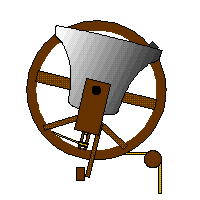In 1724 there were only 5 bells which were recast and increased to 6 by Thomas Eaye, the Kettering bell founder. The former 3rd bell was again recast in 1782 but by Edward Arnold of St Neots who was the nephew of Thomas Eayre. This was possibly because it had become cracked. The oak bell frame of 1724 was apparently rebuilt from some of the timbers of the former bell frame. This had to be enlarged in order to accommodate extra bells as there were thought to be 3 originally which were probably used only for chiming and therefore not hung in a full circle.
When John Baxter rehung the bells in 1724, under the instructions of Thomas Eayre, Thomas became friends with the daughter, Susan Baxter, whom he later married in 1725. Consequently the 6 bells are largely associated with this marriage. In 1882 they were again rehung this time by W Eaton of Titchmarch, Northamptonshire.
In 1988 the bells were once more rehung and augmented to a ring of 8. They were positioned 2m lower in the tower in order to ease the strain on the building. The main bell frame now rests upon a concrete ring beam which was constructed at this time. The two extra bells complete the octave and were cast by the Eijsbouts’ Bell Foundry at Asten, Netherlands. They were cast to the same profile as the other 6 bells. All new fittings were used although the bells of 1724 were not re-tuned. However they were an 1/8th turned to decrease the wear of the clappers on the sound bows, thickest part of the bells.
Bells were formerly hung on their head stocks by means of canons which are the loops through which iron straps were placed to hold them tight to the axle or wooden head stock. The canons on the 6 bells of 1724 are fine examples and were kept but special canon-retaining head stocks were manufactured for these bells. Modern bells are bolted through their crowns onto the head stock as canons can be a source of weakness.
When Eayre & Smith of Melbourne, Derbyshire last rehung the bells a new galvanised steel frame was used. Dr Ray Ayres, a descendant of Thomas Eayre, drew up the plans and specifications.
The ringing room was constructed in 1996 when a kitchen and toilet were installed in the ground floor of the tower. The original 12th century tower and North aisle were demolished in the 13th century for a chancel and new South aisle to be built in the 14th century along with a tower and spire. Complete restoration of the building took place in 1859 where Barnack’s stone dressings for the wall and slate and lead for the roof were used. The tower is three storeys high with four stages moulded with plinth band, an embattled parapet and clasp buttresses at the first stage. These change to diagonal buttresses capped with 18th century ball finials. Similar finials cap at the base of the original spire which was blown down during a hurricane in 1741.



